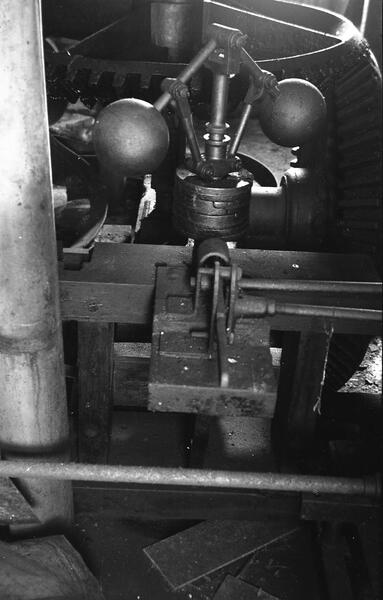| At the end of 2024 we hit a significant milestone – the 100,000th item to be catalogued from our archive. And we have still barely scratched the surface of our collections! |
 |
| The 100,000th item added to our catalogue – a photograph of the governors at Whitchurch Silk Mill, Hampshire, taken by John Reynolds – GJDR-NEG-587 |
| The size of our collections |
| Here at the Mills Archive we like to talk about having several million items in our collections in total. The truth is, estimating the total number of items in the collections is a difficult task. Our 292 collections acquired over the past 23 years range in size from a shoebox to over 100 boxes. The boxes themselves can vary in size and their contents can be large volumes, rolled drawings, paper files, print photographs or tiny negatives and 35mm slides. And what even counts as an item? Is a minute book a single item, or is each page an item? What if the minutes were not written up in a book but typed on separate sheets collected in a ring binder, or stored loose in a folder? |
 |
| A very small selection of items from our collections. |
| The fact is, we will never be completely certain how many items we hold, and the new collections coming in every year only make it all the more complicated to come up with an estimate. But we can give you the facts and figures about the items that have been listed in our online catalogue. Since we first began recording the figures over 10 years ago, the total number of records in our AtoM catalogue has almost tripled, from around 38,000 in August 2014 to the latest milestone, our 100,000th item added in December 2024.This huge increase is largely thanks to the many volunteers who have been steadily working through our collections over the years. Individuals worthy of special recognition include our most dedicated volunteer Guy Boocock who was with us for fourteen years and catalogued many of our collections, longtime supporter Guy Blythman who worked with us to catalogue the whole of his ‘Technical Information Project’ – at 10,647 entries the largest collection in the catalogue – and trustee Ashok Vaidya who has lent his time to working through several of our collections, including recently the drawings and photographs of architect John Reynolds – the collection which took us over the 100,000 mark. |
| New collections |
| The 100,000 entries in our catalogue range from descriptions of individual photographs, letters or deeds, to broader entries describing collections that may not have been catalogued yet in any detail.In 2024 we received 6 new collections and 9 major additions to existing collections, as well as other small donations. Some of these include: The John Reynolds Collection as already mentioned. John Reynolds’ 1970 book Windmills and watermills is a valuable guide and was illustrated with many of his meticulous architectural drawings. We now hold the originals, along with his photographs and papers. |
 |
| Drawings and photographs by John Reynolds. |
| The North Leverton Windmill Archive: The windmill in North Leverton was a subscription mill, paid for by the local community. It is also the only windmill in England that has never stopped working from its construction to the present day. We are grateful to the trustees of the mill for entrusting us with their archive, including the original 1812 deed with signatures of all the original subscribers. |
 |
| The 1812 agreement founding the North Leverton Subscription Mill Company. |
| The collections of mill researchers and enthusiasts Michael Yates, David Edwards, Chris Gibbings, Geoffrey Starmer, Chris Wilson and Jeff Hawksley are all valuable additions to our archive. Our collections of millwrighting plans have been enriched by additional material from Luke Bonwick and Martin Watts. |
| Looking ahead |
| Reaching 100,000 catalogued records is a testament to the dedication of everyone who has been involved in the Mills Archive over the two decades of its existence. But there is still so much more to be done. As I have mentioned, coming up with exact numbers can be tricky, but by my estimation perhaps only a tenth of the collections have been catalogued to the highest level of detail.Of course this means that we will never completely list everything – but this isn’t necessarily a bad thing. Archivists are very concerned with making sure that valuable records of the past are not lost due to carelessness and neglect, but there is another potential challenge. Today so much information is created, especially in the electronic realm, that there is a danger of missing the wood for the trees: what is important and useful could end up being swamped by unnecessary duplication and irrelevant detail. One of the most important questions we regularly face is prioritisation – deciding which collections merit preserving in the first place and which should be catalogued in most detail, as well as picking out the truly interesting and noteworthy items to highlight and promote.With so much material to work through, as well as the new collections that continue to arrive, we certainly still have our work cut out for us! |
 |
| Showing some of our items to a recent visitor – Colin Rank of the Rank milling family. |
